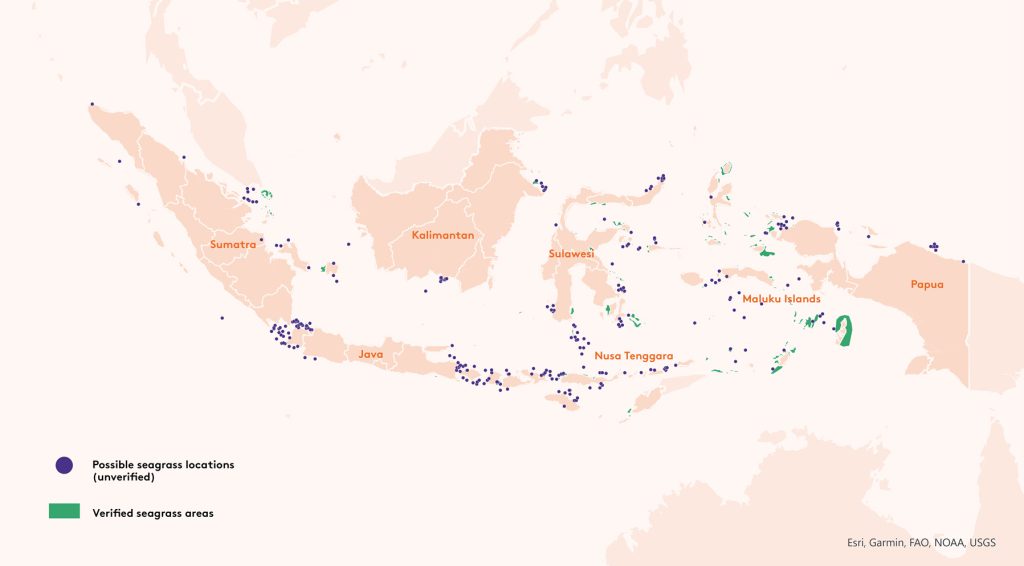Ocean-based climate action can deliver up to a quarter of the global annual greenhouse gas emissions cuts pledged under the Paris Agreement. For the first time, Climateworks has mapped and measured, in detail, Indonesia’s ocean-based mitigation potential.
In Phase 1 of the Southeast Asia Framework for Ocean Action in Mitigation (SEAFOAM) project, Climateworks explored a range of coastal and offshore mitigation options for Indonesia, collating qualitative and quantitative data on these options.
SEAFOAM analysis identified three sectors which have significant emissions mitigation opportunities for Indonesia. These include:
- Expanding protection and restoration of blue carbon ecosystems;
- Investing in offshore renewable energy
- Decarbonising the shipping and maritime transport sector.
Why is this important?
The inclusion of ocean-based climate actions into countries’ nationally determined contributions (NDCs) can help accelerate progress towards the Paris Agreement goal of limiting warming to 1.5 degrees.
Globally, the inclusion of ocean-based climate actions could result in annual emissions mitigation of 11.8 GtCO2e by 2050 – which is roughly equivalent to 31 per cent of total global fossil fuel emissions in 2021.
Indonesia is one of the most important countries globally for ocean-based climate change mitigation. It is the largest archipelagic country in the world, with an offshore area three times the size of its land area.
To date, no country with a maritime sector and economy as large and multifaceted as Indonesia’s has attempted the substantial inclusion of ocean-based measures in its NDC.
Climateworks’ SEAFOAM Phase 1 report analysed three sectors; blue carbon, offshore renewable energy and shipping.
Across sectors analysed for this report, Climateworks found ocean-based climate actions could be a central component of Indonesia’s progress towards net zero.
This is achieved through establishing targets and setting the foundations for emissions monitoring and reporting.
What the maps show us
Our analysis of blue carbon highlights seagrass potential
Indonesia has committed, under its enhanced NDC, to ecosystem protection and to becoming a carbon sink by 2030 through forestry and other land-use industries. By contrast, the role of blue carbon ecosystems is not yet well defined.
This analysis finds blue carbon ecosystems are degrading in Indonesia. Degraded blue carbon ecosystems have the potential to decrease important carbon stocks and increase Indonesia’s emissions.
SEAFOAM Phase 1 undertook initial mapping of potential current seagrass areas, to demonstrate the potential mitigation impact of reducing degradation of seagrass meadows in Indonesia.

This report highlights the potential for seagrasses to be included in NDC reporting, alongside mangroves, which already are.
There are significant gaps in seagrass data across Indonesia, particularly the scarcity of ‘ground truth’ (verified) data and the absence of an average national degradation rate. This creates challenges for quantifying seagrass emissions mitigation potential.
By including seagrasses into NDC monitoring and reporting frameworks and committing to protection and restoration there is potential to mitigate 17 – 60 MtCO2e emissions by 2030.
Significant opportunities exist for offshore renewable energy – if action starts now
The energy sector is currently Indonesia’s second major source of emissions, with heavy reliance on coal powered energy.
An increasing population and growing energy usage will increase this demand.
Indonesia has already committed to 23 per cent of national energy demand coming from new renewable energy projects by 2025. This increases to 31 per cent by 2050. These figures don’t currently include significant offshore renewable energy – which could play a considerable role in Indonesia’s generation mix in coming years.
SEAFOAM Phase 1 mapped the current potential of four offshore renewable technologies: tidal, wind, ocean thermal energy conversion (OTEC) and offshore wind, with the latter seen as the most economically and commercially deployable, with minimal environmental impact.

Climateworks findings show that if Indonesia pursued offshore wind there is potential to mitigate 0.32 MtCO2e emissions by 2030. This potential grows extensively to 2050, with an emission mitigation potential of up to 180 MtCO2e.
Analysis indicates that Papua and Maluku have the potential to generate immense energy supply from current commercially available offshore wind turbines, yet demand for energy in these provinces is low.
To capitalise on their offshore wind potential, Indonesia would therefore need to invest heavily in grid infrastructure. Alternatively, smaller capacity, low wind speed turbines, (not yet commercialised), could be deployed widely in the West of Indonesia.
Industry and infrastructure offer untapped potential
Domestic shipping and water-borne transport play an important role in the movement of people and goods between Indonesia’s many islands. Indonesia is pursuing decarbonisation efforts for domestic shipping through biodiesel. But, there are currently no targets in Indonesia’s enhanced NDC for the domestic shipping and maritime transport sectors.
To identify decarbonisation opportunities, SEAFOAM Phase 1 mapped the number of voyages and passengers carried on major domestic maritime routes.
Our analysis indicates which ferry routes are suitable for electrification, based on voyages under 40 kms (the longest commercial ferry route currently in operation).

Of the 10 most used ferry routes in Indonesia (which carried 74 per cent of all ferry passengers in 2021) eight are suitable for electrification. For example, if the ferry between Java and Bali could be electrified, this could significantly reduce emissions for 6.2 million passengers each year.
We found, by reducing carbon emissions from the sector in line with the International Renewable Energy Agency‘s 1.5 aligned decarbonisation scenario, 2.8 MtCO2e could be mitigated annually by 2030.
Phase 1 of SEAFOAM has drawn together three sectors of ocean-based climate action, to demonstrate the impact coastal and marine resources can play in decarbonisation and pathways toward net-zero.
A Summary Report, which fully details the findings and sources, will be released publicly later in 2023.
As the emissions mitigation methodology is currently undergoing peer review, mitigation figures presented may be subject to minor changes prior to release of the Summary Report.
UPDATE SEPTEMBER 2023: Summary report now available for download
See more maps and find out more about this work at our webinar:
Sea of opportunity: The role of ocean mitigation in Indonesia’s decarbonisation